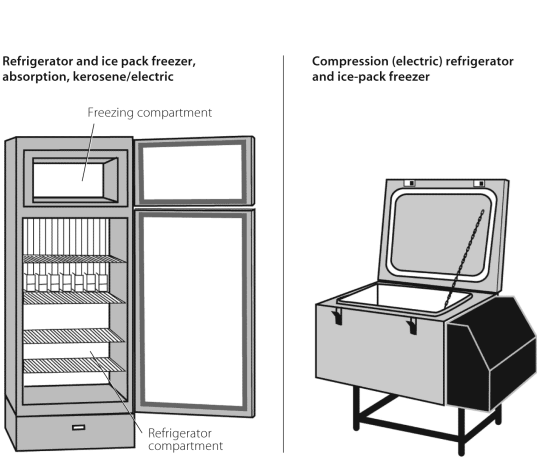
Different levels within the health care system need different equipment for transporting and storing vaccines and diluents at the correct temperature. Cold chain equipment, both electrical and non-electrical, is used for storing vaccines and/or transporting them at appropriate temperatures.
Primary vaccine stores need cold or freezer rooms, freezers, refrigerators, cold boxes, and sometimes refrigerator trucks for transportation.
Intermediate vaccine stores, depending on their size/capacity, need cold and freezer rooms, and/or freezers, refrigerators, and cold boxes.
Health facilities need refrigerators with freezing compartments, cold boxes and vaccine carriers.
There is five major cold chain equipment used in health facilities:
Health facility refrigerators may be powered by electricity, kerosene, or solar energy (Figure 4.2, below). Electric refrigerators are usually the least costly to run and the easiest to maintain, but they must have a reliable electricity supply.
Where the electricity or fuel supply is not reliable, ice-lined refrigerators can maintain the appropriate temperature for 16 hours without power if they operate with power continuously for at least eight hours a day. But the use of ice-lined refrigerators may expose vaccines to the risk of freezing. To prevent an ice-lined refrigerator from freezing vaccines, set the thermostat to 1 and put adhesive tape on the thermostat dial so that it does not get changed, and set the ice lining switch to "off".
Refrigerators have different capacities for storing vaccines and for freezing and storing ice-packs. A refrigerator in a health facility should be able to hold:
Half the total space in the refrigerator should be left empty to allow air to circulate around the vaccines and diluents to keep them cool.

A cold box is an insulated container that can be lined with ice-packs to keep vaccines and diluents cold during transportation and/or short period storage (from two to seven days) depending on the environmental condition we are working (see Figure 4.3).
Cold boxes are used to collect and transport monthly vaccine supplies from national stores to regional, zonal, district and health facility. They are also used to store vaccines when the refrigerator is out of order or being defrosted and for outreach and mobile sessions in addition to vaccine carriers.
Different models of cold boxes have different vaccine storage capacities. Health facilities usually need one or more cold boxes that can hold:
In addition to their vaccine storage capacity, cold boxes are selected according to their cold life.
Different models have a cold life of two to seven days depending on the temperature outside.
When keeping vaccines in a cold box:

Vaccine carriers, like cold boxes, are insulated containers that, when lined with frozen ice-packs, keep vaccines and diluents cold during transportation and/or temporary storage (see Figure 4.4, below). They are smaller than cold boxes and are easier to carry if walking. But they do not stay cold as long as a cold box only for a maximum of 48 hours with the lid closed.
Vaccine carriers are used to transport vaccines and diluents to outreach sites and for temporary storage during health facility immunisation sessions. In small health facilities, they are used to bring monthly vaccine supplies from the district store. Vaccine carriers are also used to store vaccines when the refrigerator is out of order or is being defrosted.
Different models of vaccine carriers have different storage capacities.
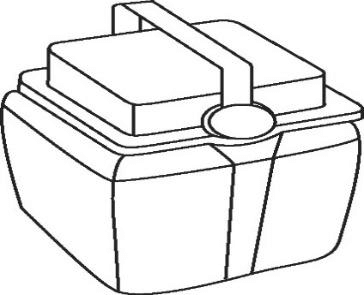
Ice-packs are flat, square plastic bottles that are filled with water and frozen. Ice-packs are used to keep vaccines cool inside the vaccine carrier or cold box. The number of ice-packs required for a cold box or vaccine carrier varies. It is recommended to condition ice-packs before using them in a vaccine carrier.
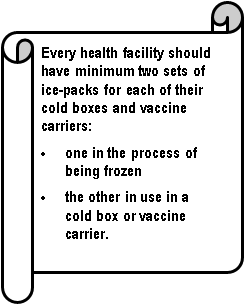
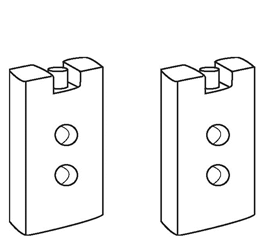
Taking ice packs out of the vaccine carrier will shorten its cold life. During sessions, it is not recommended to keep vaccines on ice-packs or in cups filled with ice to keep vaccines cool. During sessions, stick the vaccine and diluent vials into the foam pad to keep them cool and to protect them.
Ice melts quickly, and vials may become contaminated if they float in water from melted ice and labels may fall off the vials. You can avoid this by putting the vials in a sealed plastic bag. Consider open vials that have been under melted water to be contaminated and discard them.
Conditioned ice packs have first been fully frozen, and then removed from the freezer and left at room temperature for a short time (it may take over 30 minutes if the room is cold). Allow the frozen ice packs to sit at room temperature until the ice begins to melt and water starts to form.
Chilled water packs can be made by almost filling the ice pack containers or ordinary plastic water bottles with water and placing them in the main compartment of the refrigerator for about 24 hours. Using chilled water packs may be more efficient than using conditioned ice-packs because it takes more electricity, gas or kerosene, and more time, to freeze ice packs and then condition them.
A foam pad is a piece of soft foam that fits on top of the ice-packs in a vaccine carrier. There are some cuts on it to allow vaccines to be inserted in the foam (see Figure 4.5). During immunisation sessions, the foam pad serves as a temporary lid to keep unopened vaccines inside the carrier cool while providing a surface to hold, protect and keep cool opened vaccine vials. Previously, ice packs were used to keep vaccines cool during immunisation sessions outside of vaccine carriers. It is now recommended to use the supplied foam pads for this purpose.
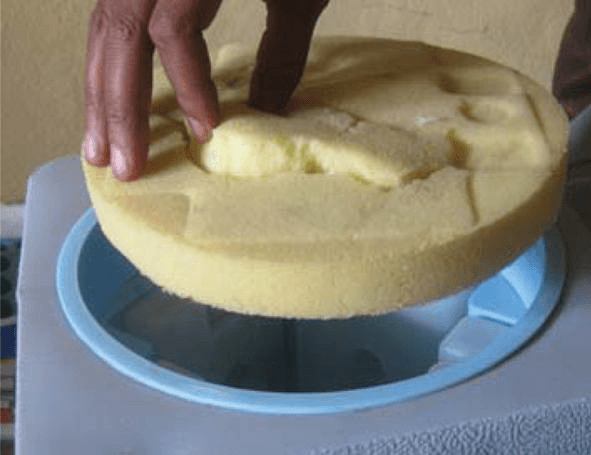
Keep all electrical cold chain equipment
The physical appearance of the vaccine may remain unchanged even after it is damaged. However, the loss of potency due to either exposure to heat or cold is permanent and cannot be regained.
All vaccines are damaged by temperatures more than +8ºC, whether they are exposed to a lot of heat for a short time (e.g., as a result of keeping vaccine in a closed vehicle in the sun) or a small amount of heat over a long period (e.g., as a result of the frequent opening of lid of vaccine carrier).
Reconstituted BCG and measles vaccines are the most sensitive to heat and light. Since these live vaccines do not contain preservatives, there is a risk of contamination with Staphylococcus aureus leading to Toxic Shock Syndrome and, therefore, they should not be used after 6 hours of reconstitution.
i) Checking for heat damage: The Vaccine Vial Monitor (VVM): a VVM is a label containing a heat-sensitive material which is placed in a vaccine vial to register cumulative heat exposure over time.The combined effects of time and temperature cause the inner square of the VVM to darken gradually and irreversibly. Before opening a vial, check the status of theVVM.
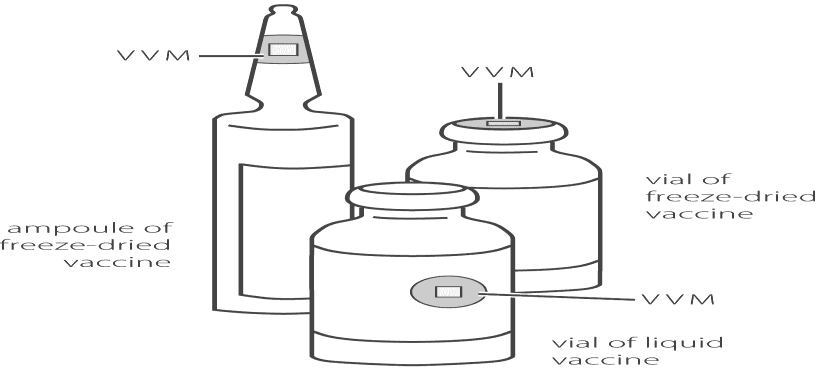
ii) Does a VVM measure vaccine potency? No, the VVM does not directly measure vaccine potency, but it gives information about the main factor that affects potency: heat exposure over a period. The VVM does not, however, measure exposure to freezing that contributes to the degradation of freeze-sensitive vaccines.
iii) Reading the stages of the VVM
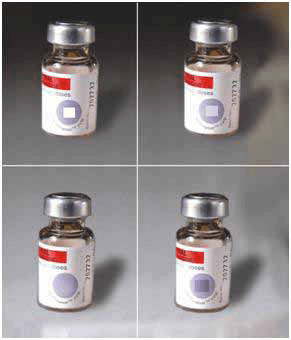
iv) Discard Point:
v) Beyond the Discard Point:
A thermometer is an instrument for monitoring the temperature of your cold chain equipment - refrigerator, cold box or vaccine carrier (Figure 4.8). It enables you to adjust the temperature to the correct range for the storage and transport of vaccines.
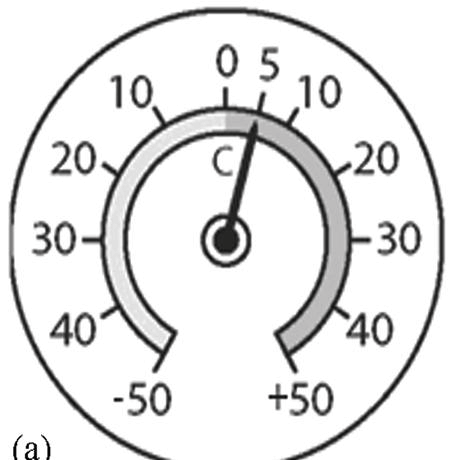

Health facility staff use dial or stem thermometers to monitor the temperature of refrigerators. On a dial thermometer, the needle moves around the scale, pointing to plus (+) numbers when it is warmer and to minus (-) numbers when it is colder. On a stem or bulb thermometer, coloured fluid in the bulb moves up the scale as it becomes warmer, and down the scale as it becomes colder.
Dial thermometers tend to lose their accuracy over time. Most dial thermometers can be recalibrated by adjusting a facility screw on the back of the thermometer. To re-calibrate, match the temperature on the dial thermometer to the temperature shown on a stem thermometer. But to be sure that the dial thermometer still works properly, make a comparison at two different temperatures i.e. inside and outside the refrigerator.
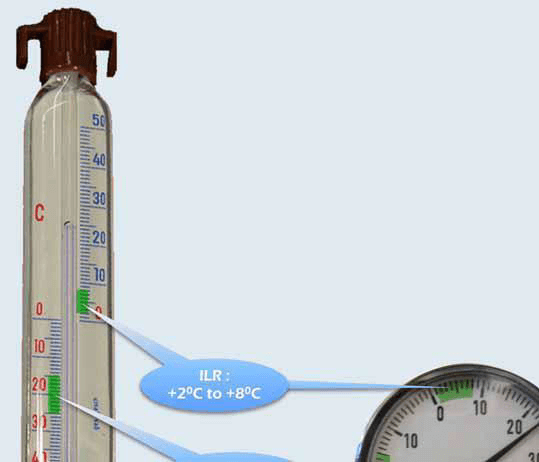
The shake test is designed to determine whether adsorbed vaccines (DPT, PCV, TT or Hepatitis B) have been frozen at some point of time in the cold chain. Once the vaccine is frozen it tends to form flakes which gradually settle to the bottom after the vial is shaken. Sedimentation occurs faster in a vaccine vial which has been frozen as compared to a vaccine vial which has not been frozen.
Conduct the shake test if you suspect that vials could have been frozen if:
Steps to perform shake test:
Step 1: take a vial of vaccine of the same batch number and from the same manufacturer as the vaccine you want to test, and freeze the vial until the contents are solid (at least 8 hours at -18°C ). Let the vial thaw by keeping it at room temperature until it becomes liquid. Label the vial as "control" clearly so that it is easily identifiable and will not be used. Similarly label the test (suspect vial).
Step 2: hold the "control" and "test" samples together in the same hand and shake vigorously for 10 to 15 seconds.
Step 3: place both the vials on a table and do not move them further.
Step 4: view both vials against the light to compare their sedimentation rates.
Note: some vials have large labels which conceal the vial contents. This makes it difficult to see the sedimentation process. In such cases, turn the control and test vials upside down and observe sedimentation taking place in the neck of the vial.
Correct storage and use of diluents:
Only use the diluents supplied and packaged by the manufacturer with the vaccine, since the diluent is specifically designed for the needs of that vaccine, on volume, PH level and chemical properties.
Store the diluents, between +2° to +8°C in the ice lined refrigerator (ILR). If there are constraints of space, then store diluents outside the cold chain. However, remember to cool diluents for at least 24 hours before use to ensure that vaccines and diluents are at +2° to +8°C when being reconstituted. Otherwise, it can lead to thermal shock i.e. the death of some or all the essential live organisms in the vaccine. Store the diluents and droppers with the vaccines in the vaccine carrier during transportation. Diluents should not come in direct contact with the ice pack.
Loading cold chain equipment:
Cold chain equipment, including refrigerators, cold boxes, and vaccine carriers, must be loaded correctly to maintain the temperature of the vaccines and diluents inside.
Vaccines, diluents, and ice-packs should be kept in a refrigerator that is used only to store them. If, however, you are in an area with only one refrigerator and you need to store other heat sensitive supplies such as drugs, ointments, serum, and samples, be sure to label them clearly and keep them separate from vaccines and diluents. Do not put vaccines on the door shelves. The temperature is too warm to store vaccines, and when the door is opened shelves are instantly exposed to room temperature. Do not keep expired vaccines, or vaccines with VVMs that have reached or are beyond their discard point, or reconstituted vaccines for more than six hours or until the end of an immunization session in the refrigerator. Discard them immediately according to your national guidelines. Refer to your supervisor. Food and drinks should not be stored in a vaccine refrigerator. Do not open the refrigerator door frequently since this raises the temperature inside the refrigerator.
Vaccine refrigerators have two compartments:
The main compartment (the refrigerator) for storing vaccines and diluents should be kept between +2ºC and +8ºC. The thermostat is used to adjust the temperature.
A second compartment (the freezer) is meant for freezing ice-packs. If the refrigerator is working properly, this section will be between -5ºC and -15ºC.
Load a vaccine refrigerator as follows:
Multi-dose vial policy:
Multi-dose vials of OPV and TT from which one or more doses of vaccine have been removed during an immunisation session may be used again within four weeks if all of the following conditions are met:
Load front-loading refrigerator with freezer on top as follows:
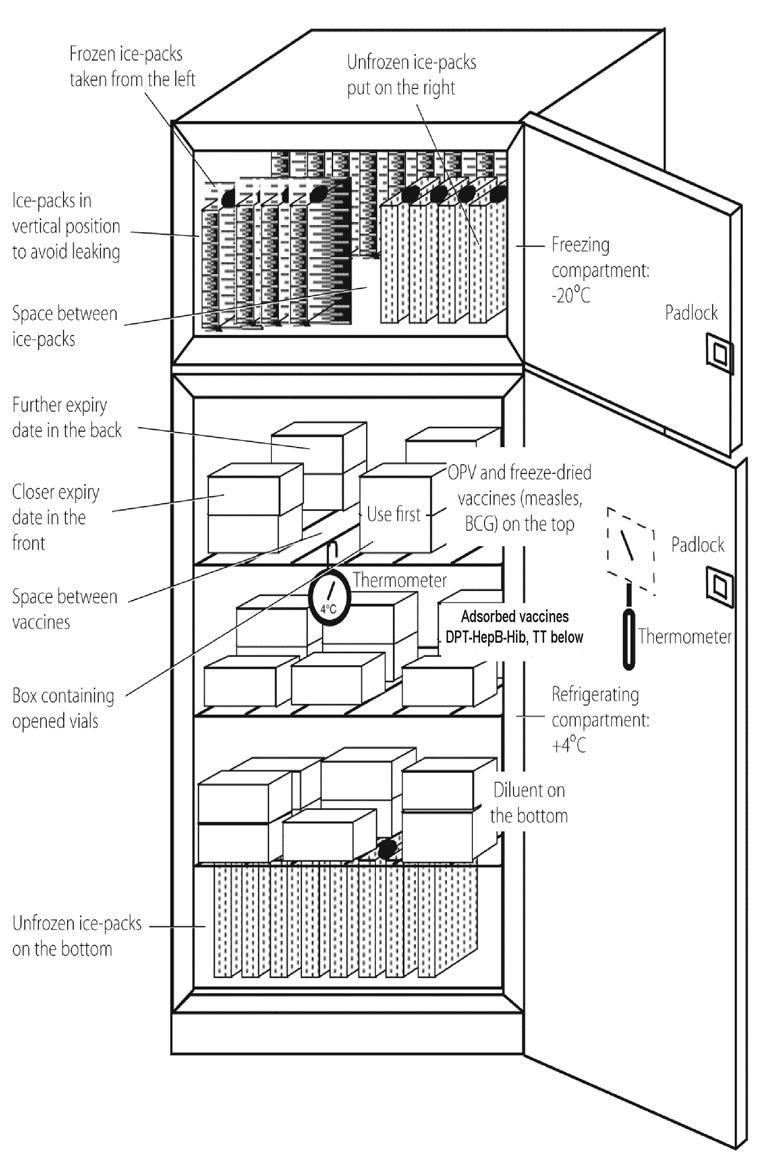
Loading ice-lined refrigerators (ILR):
All the vaccines should be stored in the basket provided with the refrigerator
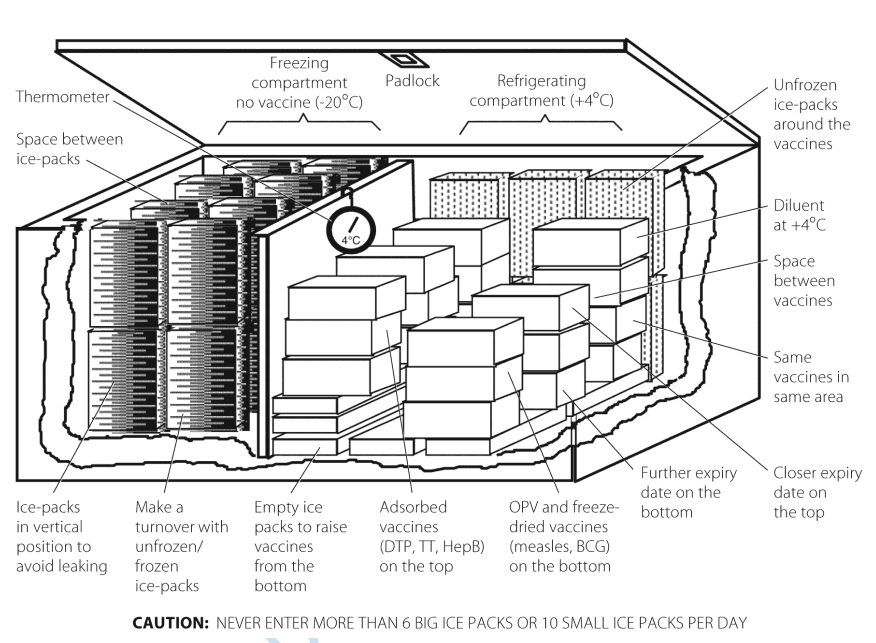
Loading cold boxes and vaccine carriers:
With 4 conditioned ice packs, maintain the inside temperature between +2ºC to +8ºC for 12 hours, if not opened frequently. They are used for carrying vaccines (16-20 vials) and diluents from PHCs to session sites. Ensure the return of unused vaccine vials from session sites to the PHC on the same day in the cold chain through alternate vaccine delivery. Keep abox labeled "returned unused" in the ILR for all unused vaccines that can be used in subsequent sessions. Discard vaccines that have been returned unopened more than thrice. Do not keep any used vials in the cold chain.
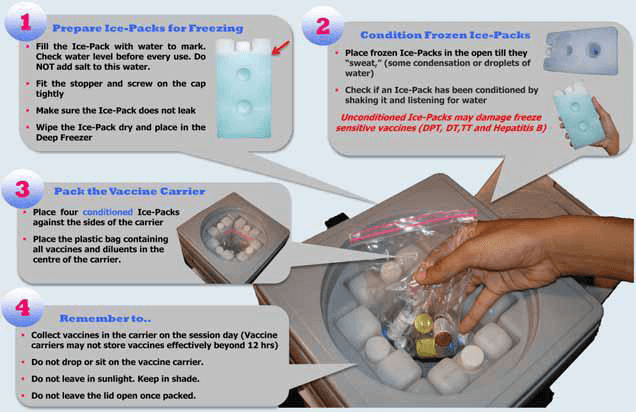
How to freeze ice packs:
To freeze an ice pack:
Keep extra unfrozen ice packs that do not fit in the freezer on the bottom part of the main refrigerator compartment to keep this section cold in case of a power failure. When you put these ice-packs into the freezer, they will freeze relatively quickly because the water inside already is cold. However, do not store already frozen ice-packs in the refrigerator compartment as this will increase the risk of freezing the vaccine.